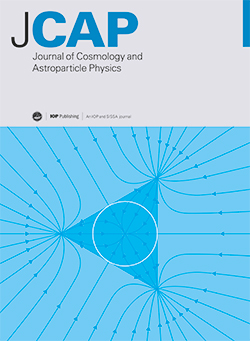高红移星系中的尘埃:调和紫外线衰减与红外线辐射
IF 5.3
2区 物理与天体物理
Q1 ASTRONOMY & ASTROPHYSICS
Journal of Cosmology and Astroparticle Physics
Pub Date : 2024-09-05
DOI:10.1088/1475-7516/2024/09/018
引用次数: 0
摘要
尘埃是星系的一个关键组成部分,但它在结构形成初期的特性仍然难以捉摸。在这里,我们提出了一个z≳ 5星系尘埃分布的简单半解析模型。我们根据对紫外衰减的估计值(利用红外辐射和紫外光谱斜率之间的 IRX-β 关系)以及 ALMA 对尘埃辐射的测量结果来校准该模型的自由参数。我们发现,观测到的尘埃辐射要求这些星系中的大部分尘埃都被保留下来(假设尘埃量与低红移源相似),但如果尘埃呈球形分布,那么适度的衰减要求尘埃的延伸率明显高于恒星。有趣的是,在我们的模型中,质量较小的星系的保留率更大。然而,所需的半径是宿主半径的很大一部分,而且大于堆叠高兹星系尘埃辐射的估计范围。如果尘埃是各向异性分布的,在明亮星系中的典型覆盖率为 ∼ 0.2-0.7,而在较暗星系中则为≲ 0.1,那么这些问题是可以调和的。本文章由计算机程序翻译,如有差异,请以英文原文为准。
Dust in high-redshift galaxies: reconciling UV attenuation and IR emission
Dust is a key component of galaxies, but its properties during the earliest eras of structure formation remain elusive. Here we present a simple semi-analytic model of the dust distribution in galaxies at z ≳ 5. We calibrate the free parameters of this model to estimates of the UV attenuation (using the IRX-β relation between infrared emission and the UV spectral slope) and to ALMA measurements of dust emission. We find that the observed dust emission requires that most of the dust expected in these galaxies is retained (assuming a similar yield to lower-redshift sources), but if the dust is spherically distributed, the modest attenuation requires that it be significantly more extended than the stars. Interestingly, the retention fraction is larger for less massive galaxies in our model. However, the required radius is a significant fraction of the host's virial radius and is larger than the estimated extent of dust emission from stacked high-z galaxies. These can be reconciled if the dust is distributed anisotropically, with typical covering fractions of ∼ 0.2–0.7 in bright galaxies and ≲ 0.1 in fainter ones.
求助全文
通过发布文献求助,成功后即可免费获取论文全文。
去求助
来源期刊

Journal of Cosmology and Astroparticle Physics
地学天文-天文与天体物理
CiteScore
10.20
自引率
23.40%
发文量
632
审稿时长
1 months
期刊介绍:
Journal of Cosmology and Astroparticle Physics (JCAP) encompasses theoretical, observational and experimental areas as well as computation and simulation. The journal covers the latest developments in the theory of all fundamental interactions and their cosmological implications (e.g. M-theory and cosmology, brane cosmology). JCAP''s coverage also includes topics such as formation, dynamics and clustering of galaxies, pre-galactic star formation, x-ray astronomy, radio astronomy, gravitational lensing, active galactic nuclei, intergalactic and interstellar matter.
 求助内容:
求助内容: 应助结果提醒方式:
应助结果提醒方式:


